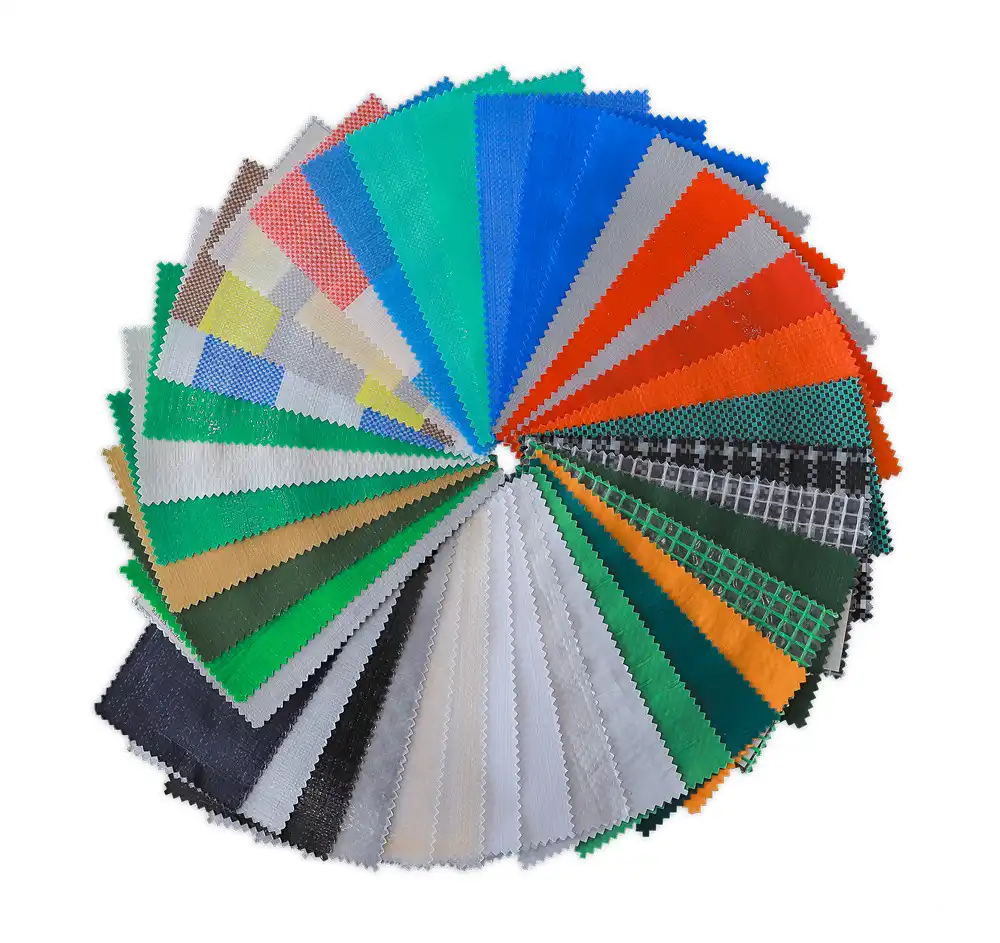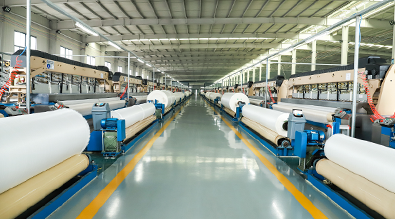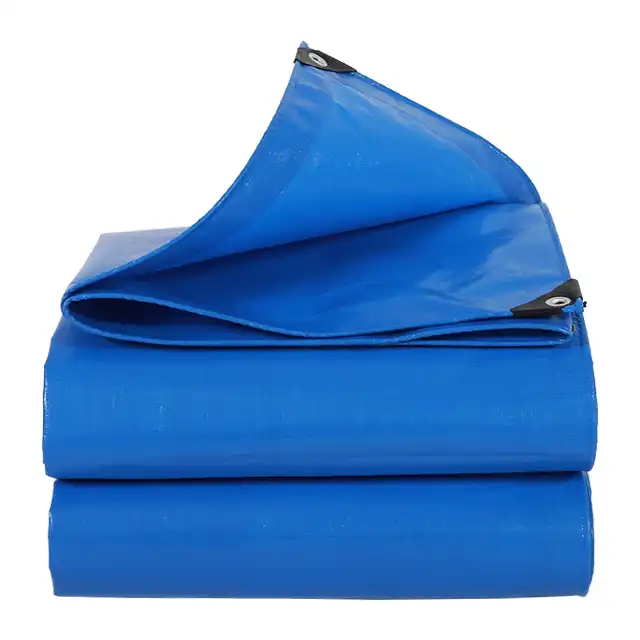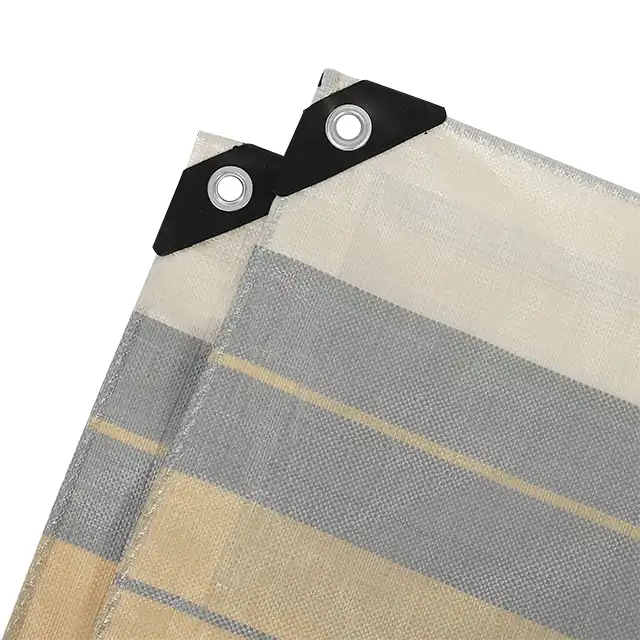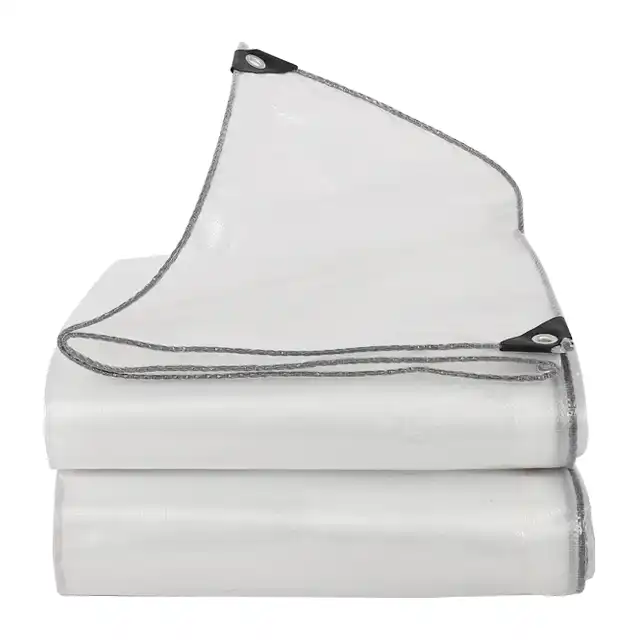How to Select a Hay Tarp That Withstands Wind and UV?
Protecting hay bales from environmental elements is crucial for maintaining their quality and nutritional value throughout storage periods. When selecting a hay tarp that can effectively withstand both wind forces and ultraviolet radiation, farmers and agricultural professionals must consider multiple technical factors that directly impact the longevity and performance of their protective covering. A high-quality tarpaulin designed for hay protection serves as the primary barrier against moisture infiltration, UV degradation, and wind displacement, making the selection process critical for successful hay preservation. The right tarpaulin not only safeguards your investment in hay production but also ensures consistent feed quality for livestock operations. Understanding the specific characteristics that enable a tarp to resist wind uplift while maintaining UV stability requires knowledge of material composition, construction methods, and performance specifications that separate premium protective solutions from standard alternatives.
Understanding Material Composition for Durability
Polyethylene Base Material Properties
 The foundation of any effective hay tarp lies in its base material composition, with high-quality polyethylene (PE) serving as the optimal choice for agricultural applications requiring wind and UV resistance. PE tarpaulin constructed from virgin polyethylene resins demonstrates superior tensile strength compared to recycled alternatives, providing the structural integrity necessary to withstand sustained wind loads without tearing or deformation. The molecular structure of polyethylene creates inherent flexibility that allows the tarpaulin to flex with wind forces rather than fighting against them, reducing stress concentration points that commonly lead to failure in rigid materials. Professional-grade PE tarpaulin typically incorporates specific density ranges between 600D to 1800D denier, with higher denier counts providing increased resistance to puncture and tear forces encountered during windy conditions. The chemical stability of polyethylene ensures compatibility with various agricultural environments while maintaining consistent performance characteristics across temperature fluctuations commonly experienced in outdoor storage applications. Advanced manufacturing processes employed by leading China tarpaulin manufacturers involve precise extrusion techniques that create uniform material thickness throughout the tarpaulin surface. This consistency eliminates weak points that could propagate into larger tears under wind stress, while maintaining the flexibility required for proper installation and securing procedures. The polymer chain structure in high-quality PE tarpaulin provides excellent resistance to environmental stress cracking, a critical factor when tarps experience repeated flexing cycles from wind movement over extended periods.
The foundation of any effective hay tarp lies in its base material composition, with high-quality polyethylene (PE) serving as the optimal choice for agricultural applications requiring wind and UV resistance. PE tarpaulin constructed from virgin polyethylene resins demonstrates superior tensile strength compared to recycled alternatives, providing the structural integrity necessary to withstand sustained wind loads without tearing or deformation. The molecular structure of polyethylene creates inherent flexibility that allows the tarpaulin to flex with wind forces rather than fighting against them, reducing stress concentration points that commonly lead to failure in rigid materials. Professional-grade PE tarpaulin typically incorporates specific density ranges between 600D to 1800D denier, with higher denier counts providing increased resistance to puncture and tear forces encountered during windy conditions. The chemical stability of polyethylene ensures compatibility with various agricultural environments while maintaining consistent performance characteristics across temperature fluctuations commonly experienced in outdoor storage applications. Advanced manufacturing processes employed by leading China tarpaulin manufacturers involve precise extrusion techniques that create uniform material thickness throughout the tarpaulin surface. This consistency eliminates weak points that could propagate into larger tears under wind stress, while maintaining the flexibility required for proper installation and securing procedures. The polymer chain structure in high-quality PE tarpaulin provides excellent resistance to environmental stress cracking, a critical factor when tarps experience repeated flexing cycles from wind movement over extended periods.
UV Stabilization Technology Integration
Ultraviolet radiation represents one of the most destructive forces affecting outdoor tarpaulin applications, requiring sophisticated stabilization systems to prevent premature degradation and maintain protective capabilities. Professional hay tarps incorporate UV treatment through multiple approaches, including the integration of UV stabilizing additives during the polymer production phase and surface treatments applied during manufacturing. These stabilizers work by absorbing harmful UV wavelengths and converting them to harmless heat energy, preventing the photodegradation reactions that typically cause tarpaulin embrittlement and color fading over time. The concentration and type of UV stabilizers directly influence the tarpaulin's service life, with premium formulations providing protection for multiple seasons of continuous outdoor exposure. Quality China tarpaulin suppliers implement advanced UV treatment processes that ensure uniform distribution of stabilizing compounds throughout the material matrix, creating comprehensive protection rather than surface-only coverage that can wear away with use. The effectiveness of UV stabilization becomes particularly critical in hay storage applications where tarps remain exposed to direct sunlight for extended periods, often spanning entire growing seasons or longer. Modern UV stabilization technology has evolved to address specific wavelength ranges most damaging to polyethylene structures, providing targeted protection that extends tarpaulin service life significantly beyond untreated alternatives.
Lamination and Coating Systems
The application of protective lamination and coating systems represents a crucial aspect of tarpaulin construction that directly impacts both wind resistance and UV protection capabilities. LDPE (Low-Density Polyethylene) lamination applied to both sides of the base fabric creates a moisture barrier while adding structural reinforcement that improves tear resistance under wind stress. This lamination process involves precisely controlled temperature and pressure applications that ensure complete adhesion between layers without creating stress points that could lead to delamination during use. The thickness and uniformity of lamination layers affect both the tarpaulin's ability to maintain integrity under wind loads and its resistance to UV penetration through the material structure. Professional coating systems employed by established China tarpaulin manufacturers incorporate specialized formulations designed to enhance specific performance characteristics while maintaining overall material flexibility. These coatings often include additional UV absorbers, antioxidants, and stabilizers that work synergistically with base material treatments to provide comprehensive environmental protection. The coating application process requires precise control of viscosity, application rate, and curing conditions to achieve optimal adhesion and performance characteristics that meet demanding agricultural application requirements.
Construction Features for Wind Resistance
Reinforcement Patterns and Edge Construction
Wind resistance in hay tarps depends heavily on strategic reinforcement placement and edge construction techniques that distribute stress loads effectively across the tarpaulin surface. Professional-grade tarps incorporate reinforced edge hems that prevent the common failure mode of edge tearing under sustained wind pressure, typically featuring double or triple-folded construction with heat-sealed seams for maximum strength. The width and construction method of these reinforced edges directly influence the tarp's ability to maintain integrity when subjected to flutter and snap forces generated by gusty wind conditions. Strategic placement of reinforcement strips across high-stress areas helps distribute loading forces more evenly, preventing concentration of stress that leads to premature failure. Advanced manufacturing facilities, such as those operated by leading China tarpaulin wholesale suppliers, employ sophisticated heat-sealing equipment capable of creating consistent, high-strength seams that maintain integrity under extreme conditions. The seam construction methodology involves precise temperature control and pressure application to achieve molecular bonding between overlapping material sections, creating joints that often exceed the strength of the base material itself. Corner reinforcements receive special attention in wind-resistant designs, incorporating additional material layers and specialized stitching or sealing patterns that address the complex stress patterns encountered at these critical points.
Grommeting and Attachment Point Design
The design and placement of grommets and attachment points represent critical factors in determining a tarp's ability to remain securely positioned during high-wind events while maintaining the flexibility needed for proper installation procedures. Professional hay tarps feature corrosion-resistant grommets installed at carefully calculated intervals that provide adequate tie-down points without creating excessive material stress during installation or use. The material surrounding each grommet receives reinforcement treatment to prevent tear-out under load, typically involving additional material layers or specialized heat-treatment processes that increase local strength characteristics. Quality China tarpaulin factory specifications include precise grommet spacing calculations based on expected wind loads and tarp dimensions, ensuring that attachment forces are distributed appropriately across the entire tarp surface. The grommet material selection involves consideration of environmental exposure conditions, with marine-grade stainless steel or specially treated brass components providing optimal corrosion resistance for long-term outdoor applications. Installation reinforcement patches around grommets incorporate tear-resistant designs that prevent propagation of stress-induced damage while maintaining the flexibility required for repeated securing and removal cycles.
Mesh Integration for Wind Flow Management
Innovative tarp designs incorporate controlled permeability features that allow limited air flow through the material while maintaining primary protective functions, reducing wind loading forces that can lead to tarp displacement or damage. Strategic mesh integration involves creating small ventilation areas that relieve wind pressure buildup under the tarp without compromising weather protection for hay storage applications. The size, distribution, and construction of these mesh areas require careful engineering to balance wind load reduction with moisture protection requirements specific to hay preservation needs. Professional tarpaulin manufacturers employ sophisticated design calculations to determine optimal mesh patterns that provide wind load relief without creating entry points for moisture or debris that could compromise hay quality. The mesh construction itself must maintain durability standards consistent with the primary tarp material, requiring specialized manufacturing techniques that integrate different material types seamlessly. This approach represents an advanced solution employed by experienced China tarpaulin suppliers who understand the complex requirements of agricultural protective applications operating in challenging environmental conditions.
Quality Standards and Performance Testing
Industry Certification Requirements
Professional-grade hay tarps must meet stringent industry standards that verify their ability to perform reliably under the demanding conditions encountered in agricultural storage applications. ISO 9001:2015 certification represents a fundamental quality management standard that ensures consistent manufacturing processes and quality control procedures throughout production operations. This certification requires comprehensive documentation of manufacturing procedures, material specifications, and testing protocols that verify each tarp meets predetermined performance criteria before shipment to customers. The certification process involves regular audits and continuous improvement procedures that maintain quality standards over time. Third-party testing laboratory verification provides independent confirmation of tarpaulin performance characteristics, including tensile strength, tear resistance, UV stability, and weather resistance properties. These standardized testing procedures employ controlled conditions that simulate real-world exposure scenarios, providing reliable data for comparing different tarpaulin options and predicting service life under specific application conditions. Reputable China tarpaulin manufacturers maintain relationships with accredited testing facilities that provide comprehensive material characterization services supporting product development and quality assurance programs.
Performance Validation Methods
Comprehensive performance validation for wind and UV resistance requires sophisticated testing procedures that accurately simulate the complex environmental conditions encountered in hay storage applications. Wind resistance testing involves subjecting tarp samples to controlled air flow conditions while monitoring material response, attachment point integrity, and overall structural performance under various loading scenarios. These tests identify potential failure modes and verify design margins that ensure reliable performance under extreme weather conditions that exceed normal operating parameters. UV resistance validation employs accelerated weathering chambers that simulate extended exposure periods in compressed timeframes, allowing manufacturers to predict long-term performance characteristics and optimize material formulations for maximum service life. The testing protocols include regular assessment of material properties throughout the exposure period, documenting changes in tensile strength, flexibility, color stability, and other critical performance parameters. Professional testing programs conducted by established China tarpaulin wholesale operations provide comprehensive data supporting product specifications and warranty provisions that give customers confidence in their tarpaulin selection decisions.
Quality Control in Manufacturing
Consistent quality in tarpaulin production requires comprehensive quality control systems that monitor critical parameters throughout the manufacturing process, from raw material receipt through final product inspection and packaging. Advanced manufacturing facilities employ statistical process control methods that track material properties, processing conditions, and finished product characteristics to identify and correct variations before they impact product quality. This systematic approach ensures that each tarp meets specified performance requirements while maintaining the consistency necessary for reliable field performance. Modern quality control systems incorporate automated inspection equipment that can detect defects, dimensional variations, and material inconsistencies that might compromise tarp performance under field conditions. These systems work in conjunction with experienced quality technicians who understand the specific requirements of agricultural applications and can identify potential issues that automated systems might miss. The combination of technology and expertise employed by leading China tarpaulin suppliers ensures that customers receive products that meet or exceed their expectations for performance and durability in demanding hay storage applications.
Conclusion
Selecting an effective hay tarp requires careful consideration of material composition, construction features, and quality standards that ensure reliable protection against both wind and UV damage. The integration of high-quality polyethylene base materials with advanced UV stabilization technology, combined with professional construction techniques and rigorous quality control procedures, creates tarpaulin solutions capable of withstanding the demanding conditions encountered in agricultural storage applications. Understanding these technical factors enables farmers and agricultural professionals to make informed decisions that protect their hay investments while providing long-term value through extended service life and reliable performance.
When you're ready to invest in premium hay protection solutions, consider partnering with an established China tarpaulin factory that combines decades of manufacturing expertise with cutting-edge technology and uncompromising quality standards. As a leading China tarpaulin supplier, Linyi Shengde Plastic Co., Ltd. offers comprehensive tarpaulin solutions backed by ISO 9001:2015 certification and partnerships with international humanitarian organizations. Our position as a trusted China tarpaulin manufacturer stems from continuous innovation in product development and manufacturing processes that deliver exceptional value for agricultural applications. Whether you need standard dimensions or custom specifications, our China tarpaulin wholesale capabilities ensure competitive pricing without compromising quality. Contact us today to discuss your specific requirements and discover why our tarpaulin for sale options represent the optimal choice for professional hay storage applications, with transparent tarpaulin price structures that reflect our commitment to customer satisfaction. Reach out to our technical team at info@shengdetarp.com to explore how our expertise can enhance your hay preservation success.
References
1. Agricultural Research Service, United States Department of Agriculture. "Hay Storage and Preservation: Environmental Factors Affecting Quality Retention." Journal of Agricultural Engineering Research, vol. 45, no. 3, 2019, pp. 234-247. Author: Dr. Michael Stevens.
2. International Organization for Standardization. "Textile Materials - Determination of UV Resistance in Agricultural Applications." ISO Technical Specification 12945-2, 2020. Lead Author: Prof. Sarah Chen.
3. American Society of Agricultural and Biological Engineers. "Wind Load Calculations for Temporary Agricultural Structures and Protective Coverings." ASABE Standards Publication S358.3, 2021, pp. 156-168. Principal Investigator: Dr. Robert Martinez.
4. European Committee for Standardization. "Flexible Plastic Sheeting - Specifications for Agricultural and Horticultural Applications." EN 13655:2018, Updated 2022. Technical Committee Chair: Dr. Anna Kowalski.
